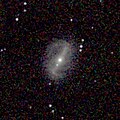NGC 6217
In today's world, NGC 6217 has become an increasingly relevant topic of interest. Whether we are talking about technology, science, politics, economics or any other field, NGC 6217 plays a fundamental role in our lives. With the advancement of society and the development of new ideas, NGC 6217 has acquired an importance that cannot be ignored. In this article, we will explore the different facets of NGC 6217, analyzing its impact on various aspects of everyday life. From its origin to its current evolution, NGC 6217 has been a topic of constant discussion in the contemporary world.
| NGC 6217 | |
|---|---|
 NGC 6217 photographed by the Hubble Space Telescope | |
| Observation data (J2000 epoch) | |
| Constellation | Ursa Minor |
| Right ascension | 16h 32m 39.217s[1] |
| Declination | +78° 11′ 53.56″[1] |
| Redshift | 0.004543 ± 0.000013[2] |
| Heliocentric radial velocity | 1,368[3] km/s |
| Distance | 67.2 Mly (20.6 Mpc)[3] |
| Apparent magnitude (V) | 11.2[4] |
| Characteristics | |
| Type | (R)SB(rs)bc[5] |
| Apparent size (V) | 55,000 light years |
| Other designations | |
| ARP 185, UGC 10470[2][6] | |
NGC 6217 is a barred spiral galaxy located some 67 million light years away,[3] in the constellation Ursa Minor. It can be located with a 10 cm (4 in) or larger telescope as an 11th magnitude object about 2.5° east-northeast of the star Zeta Ursae Minoris.[4] The galaxy is inclined by an angle of 33° to the line of sight along a position angle of 162°.[3]
A morphological classification of (R')SB(rs)bc[5] indicates that NGC 6217 has a false outer ring-like structure formed from the spiral arms (R'), a well-defined bar running across the nucleus (SB), a partial inner ring (rs), and moderately-wound spiral arms (bc).[7] The nucleus is spherical in shape, showing no indication of oblateness.[5] The prominent bar spans an angular distance of 48″ (48 arc seconds) across the galaxy along a position angle of 35.97° ± 0.35°. At 10″ southeast of the nucleus is a prominent region of star formation. The inner ring is about 43″.5 across.[8]
NGC 6217 has been characterized as a starburst galaxy, which means it is undergoing a high rate of star formation compared to a typical galaxy. As a result, the spectrum is dominated by stellar photoionization from young, hot stars.[9] This component is less than 10 million years old, producing a blue-hued spectral continuum with absorption weak lines from elements other than hydrogen and helium.[6] At the core of the galaxy is a low-luminosity active galactic nucleus which has formed an H II region.[10]
One supernova has been observed in NGC 6217: SN 2018gj (type II, mag 14.4).[11]
Gallery
References
- ^ a b Skrutskie, Michael F.; Cutri, Roc M.; Stiening, Rae; Weinberg, Martin D.; Schneider, Stephen E.; Carpenter, John M.; Beichman, Charles A.; Capps, Richard W.; Chester, Thomas; Elias, Jonathan H.; Huchra, John P.; Liebert, James W.; Lonsdale, Carol J.; Monet, David G.; Price, Stephan; Seitzer, Patrick; Jarrett, Thomas H.; Kirkpatrick, J. Davy; Gizis, John E.; Howard, Elizabeth V.; Evans, Tracey E.; Fowler, John W.; Fullmer, Linda; Hurt, Robert L.; Light, Robert M.; Kopan, Eugene L.; Marsh, Kenneth A.; McCallon, Howard L.; Tam, Robert; Van Dyk, Schuyler D.; Wheelock, Sherry L. (1 February 2006). "The Two Micron All Sky Survey (2MASS)". The Astronomical Journal. 131 (2): 1163–1183. Bibcode:2006AJ....131.1163S. doi:10.1086/498708. ISSN 0004-6256. S2CID 18913331.
- ^ a b "NGC 6216", NASA/IPAC Extragalactic Database, retrieved 2013-06-20.
- ^ a b c d Gusev, A. S.; et al. (August 2012), "Oxygen and nitrogen abundances of H II regions in six spiral galaxies", Monthly Notices of the Royal Astronomical Society, 424 (3): 1930–1940, arXiv:1205.3910, Bibcode:2012MNRAS.424.1930G, doi:10.1111/j.1365-2966.2012.21322.x, S2CID 118437910.
- ^ a b O'Meara, Stephen James (2007), Steve O'Meara's Herschel 400 Observing Guide, Cambridge University Press, p. 227, ISBN 978-0521858939.
- ^ a b c Ann, Hong Bae (December 2003), "CCD Surface Photometry of Spiral Galaxies: Bulge Morphology", Journal of the Korean Astronomical Society, 36 (4): 261–270, Bibcode:2003JKAS...36..261A, doi:10.5303/jkas.2003.36.4.261.
- ^ a b Cid Fernandes, Roberto; González Delgado, Rosa M.; Schmitt, Henrique; Storchi-Bergmann, Thaisa; Martins, Lucimara P.; Pérez, Enrique; Heckman, Timothy; Leitherer, Claus; Schaerer, Daniel (April 2004), "The Stellar Populations of Low-Luminosity Active Galactic Nuclei. I. Ground-based Observations", Astrophysical Journal, 605 (1): 105–126, arXiv:astro-ph/0401416, Bibcode:2004ApJ...605..105C, doi:10.1086/382217, S2CID 119101213.
- ^ Buta, Ronald J.; et al. (2007), Atlas of Galaxies, Cambridge University Press, pp. 13–17, ISBN 978-0521820486.
- ^ Cabrera-Lavers, A.; Garzón, F. (March 2004), "An Optical Study of a Sample of Spiral Galaxies", The Astronomical Journal, 127 (3): 1386–1404, Bibcode:2004AJ....127.1386C, doi:10.1086/381924.
- ^ Elfhag, T.; et al. (February 1996), "A CO survey of galaxies with the SEST and the 20-m Onsala telescope", Astronomy and Astrophysics Supplement, 115: 439–468, Bibcode:1996A&AS..115..439E.
- ^ Véron-Cetty, M.-P.; Véron, P. (July 2010), "A catalogue of quasars and active nuclei", Astronomy and Astrophysics, 518 (13th ed.): A10, Bibcode:2010A&A...518A..10V, doi:10.1051/0004-6361/201014188.
- ^ Transient Name Server entry for SN 2018gj. Retrieved 5 January 2023.
External links
 Media related to NGC 6217 at Wikimedia Commons
Media related to NGC 6217 at Wikimedia Commons- "Hubble Opens New Eyes on the Universe", Hubble Site news Center, NASA, September 9, 2009, retrieved 2013-06-18
- "NGC 6217". SIMBAD. Centre de données astronomiques de Strasbourg. Retrieved 2013-06-20.

